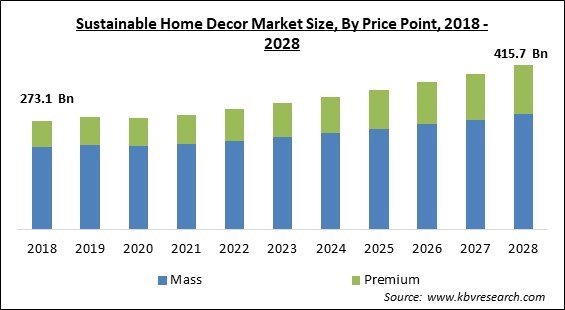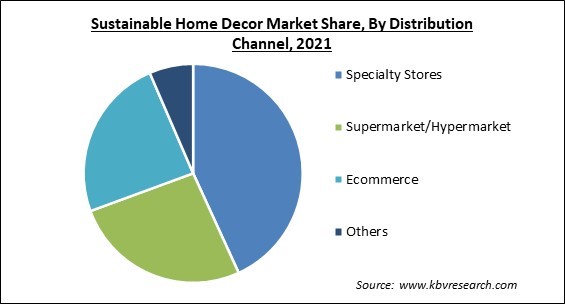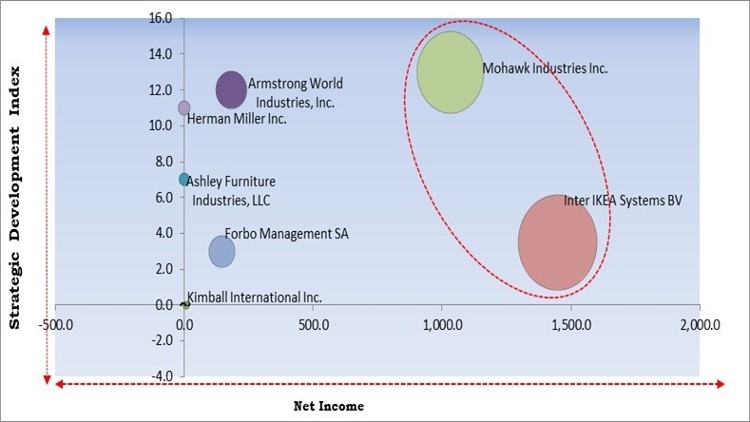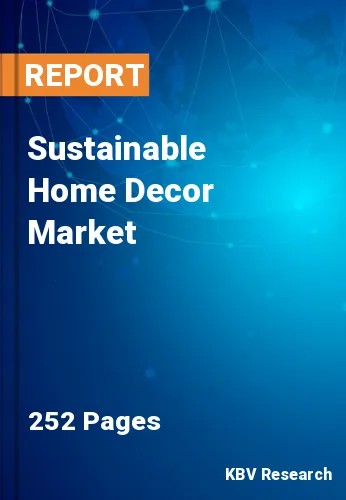The Global Sustainable Home Decor Market size is expected to reach $415.7 billion by 2028, rising at a market growth of 5.4% CAGR during the forecast period.
Sustainable home décor is the practice of designing indoor and outdoor areas that are both visually beautiful and functional for occupants. From furniture to floor coverings like tiles, wood & laminate, vinyl & rubber, carpets & rugs, and others, sustainable home décor products are available. They also consist of textiles for the home, such as rugs, textiles for the bathroom, bedding, kitchen, and dining areas, and textiles for the living room.

Furniture designs can be changed using automated and manual processes. Home décor is popular globally, and generalists are learning different techniques for keeping their homes beautiful and serene. According to the United States Environmental Protection Agency (EPA), sustainability is founded on the straightforward tenet that everything people require for their existence and well-being depends on the natural world, either directly or indirectly.
Social, environmental, and economic sustainability are the three widely acknowledged elements of sustainability. To truly be sustainable, these elements must be combined. By adopting clever, environmentally conscious design, the sustainable design seeks to ensure that there are no adverse effects on the environment. This entails utilizing renewable resources, having minimal influence on the environment, and fostering a sense of connection between people and nature.
The implementation of eco-friendly materials and practices is also a way to contribute to sustainable homemaking. Typically, this refers to items that support eco-friendly living or actions that promote the efficient use of natural resources like water and electricity. Additionally, eco-friendly products reduce their impact on contamination of the air, water, and land. Sustainability also depends heavily on ethics, so consumers also prefer brands that value their creators highly. A number of these firms have "Fair Trade" certificates, and many of them collaborate with master craftspeople to sustain traditional crafts.
A major impact of the pandemic was the emergence of work-from-home. This change was so big that it created a whole new range of furnishing products out of the limited catalogs. Major companies have come up with a unique work-from-home furniture range. By the time the pandemic settled a little, people became more inclined towards an earth-first approach in their choices. So many companies also got this hint and came up with products to quench such demands. In this way, COVID has a positive effect on the sustainable home décor market.
One major reason for the growth of the sustainable home décor market is the adoption and promotion of ‘green construction’ by major builders and real estate companies. The fast pacing urbanization is usually accompanied by the installation of sustainable home décor. This becomes profitable in two ways. Firstly, the issuing of green certificates by institutions like the U.S. Green Building Council (USGBC), Green Building Certification Institute (GBCI), and National Center for Construction Education and Research (NCCER). Secondly, this increases engagement among builders and home buyers.

The online home furnishing retailing business would grow due to the significant e-commerce growth across the world. The expansion of house furniture online commerce is also being fueled by rising expending on home furnishings. The emergence of new opportunities for consumers to shop online is one of the key factors influencing the online purchase of home furnishings like chairs, beds, tables, and closets. Due to significant discounts, comfort, and trendy designs, consumers are more likely to purchase foldable, multipurpose, and technologically advanced furniture through e-commerce websites, which is primarily responsible for the growth of these platforms.
The rise of counterfeit and sub-par products in the sustainable home décor market gives the thought of eco-friendly and green furniture a negative connotation. Firstly, it makes manufacturers refrain from coming up with any original ideas. Considering the fact that furniture industries involve huge investments, the acceptance of counterfeit products makes that investment unnecessary. It also puts the whole design environment irrelevant. Some other issue related to counterfeit and sub-par products is environmental testing. While the original pieces go through numerous tests to get their proper certifications, the counterfeit doesn’t.
Based on price point, the sustainable home décor market is bifurcated into premium and mass. The mass segment dominated the revenue share of the sustainable home décor market in 2021. Increased mass market product consumption by lower middle class and upper-middle-class customers has a substantial positive impact on the sustainable home decor market's expansion. The need for more mass-produced sustainable home decor products will increase, as more people move into the middle class.
On the basis of income group, the sustainable home décor market is segmented into lower middle income, upper middle income, and higher income. The higher income segment procured the maximum revenue share in the market of sustainable home décor in 2021. The high-income consumer segment is prone to impulsive purchases, which is a major market driver. The purchasing pattern of the higher income people would happen to be on the expensive side as well.
Based on distribution channel, the sustainable home décor market is classified into supermarkets and hypermarkets, specialty stores, e-commerce, and others. The supermarkets and hypermarkets segment procured a significant revenue share in the market of sustainable home décor in 2021. Demand for supermarkets and hypermarkets is being driven by the presence of furniture, which allows customers to shop for all of their home goods under one roof. Along with that, various offers are being given by these stores to attract more customers and hence, augmenting the growth of the segment.
On the basis of product type, the market for sustainable home décor can be categorized into floor covering, furniture, and home textile. The furniture segment witnessed a substantial revenue share in the market of sustainable home décor in 2021. Due to environmental concerns, many sustainable furniture makers exclusively use natural materials and stay away from synthetics. They also place a strong emphasis on renewable natural materials, such as fast-growing bamboo and reclaimed wood items. Such types of furniture are mostly certified by Forest Stewardship Council (FSC).
| Report Attribute | Details |
|---|---|
| Market size value in 2021 | USD 290 Billion |
| Market size forecast in 2028 | USD 415.7 Billion |
| Base Year | 2021 |
| Historical Period | 2018 to 2020 |
| Forecast Period | 2022 to 2028 |
| Revenue Growth Rate | CAGR of 5.4% from 2022 to 2028 |
| Number of Pages | 252 |
| Number of Tables | 443 |
| Report coverage | Market Trends, Revenue Estimation and Forecast, Segmentation Analysis, Regional and Country Breakdown, Competitive Landscape, Companies Strategic Developments, Company Profiling |
| Segments covered | Price Point, Income Group, Distribution Channel, Product Type, Region |
| Country scope | US, Canada, Mexico, Germany, UK, France, Russia, Spain, Italy, China, Japan, India, South Korea, Singapore, Malaysia, Brazil, Argentina, UAE, Saudi Arabia, South Africa, Nigeria |
| Growth Drivers |
|
| Restraints |
|
Region-wise, the sustainable home décor market is analyzed across North America, Europe, Asia Pacific, and LAMEA. The North America segment garnered the largest revenue share in the market for sustainable home décor in 2021. Its highly developed retail infrastructure is the reason for this. A major factor driving the growth of the market is the rising acceptability of sustainable home decor products around the world as a result of aggressive advertising and celebrity brand endorsements.
Free Valuable Insights: Global Sustainable Home Decor Market size to reach USD 415.7 Billion by 2028

The major strategies followed by the market participants are Product Launches. Based on the Analysis presented in the Cardinal matrix; Mohawk Industries Inc. and Inter IKEA Systems BV are the forerunners in the Sustainable Home Decor Market. Companies such as Armstrong World Industries, Inc., Ashley Furniture Industries, LLC and Herman Miller Inc. are some of the key innovators in Sustainable Home Decor Market.
The market research report covers the analysis of key stake holders of the market. Key companies profiled in the report include Armstrong World Industries, Inc., Mohawk Industries Inc., Inter IKEA Systems B.V., Herman Miller, Inc., Forbo Management SA, Kimball International Inc., Ashley Furniture Industries, LLC, Cisco Brothers Corp., Duresta Upholstery Ltd., and Greenington Fine Bamboo.
By Price Point
By Distribution Channel
By Income Group
By Product Type
By Geography
The global Sustainable Home Decor Market size is expected to reach $415.7 billion by 2028.
Government-Issued Certifications And Credentials For Green Construction are driving the market in coming years, however, The Rise In Counterfeit Products And Sub-Par Products restraints the growth of the market.
Armstrong World Industries, Inc., Mohawk Industries Inc., Inter IKEA Systems B.V., Herman Miller, Inc., Forbo Management SA, Kimball International Inc., Ashley Furniture Industries, LLC, Cisco Brothers Corp., Duresta Upholstery Ltd., and Greenington Fine Bamboo.
The Specialty Stores segment acquired maximum revenue share in the Global Sustainable Home Decor Market by Distribution Channel in 2021 thereby, achieving a market value of $172.5 billion by 2028.
The Floor Covering segment is leading the Global Sustainable Home Decor Market by Product Type in 2021 thereby, achieving a market value of $201.4 billion by 2028.
The Asia Pacific market dominated the Global Sustainable Home Decor Market by Region in 2021, and would continue to be a dominant market till 2028; thereby, achieving a market value of $151,308.8 million by 2028.
Our team of dedicated experts can provide you with attractive expansion opportunities for your business.

